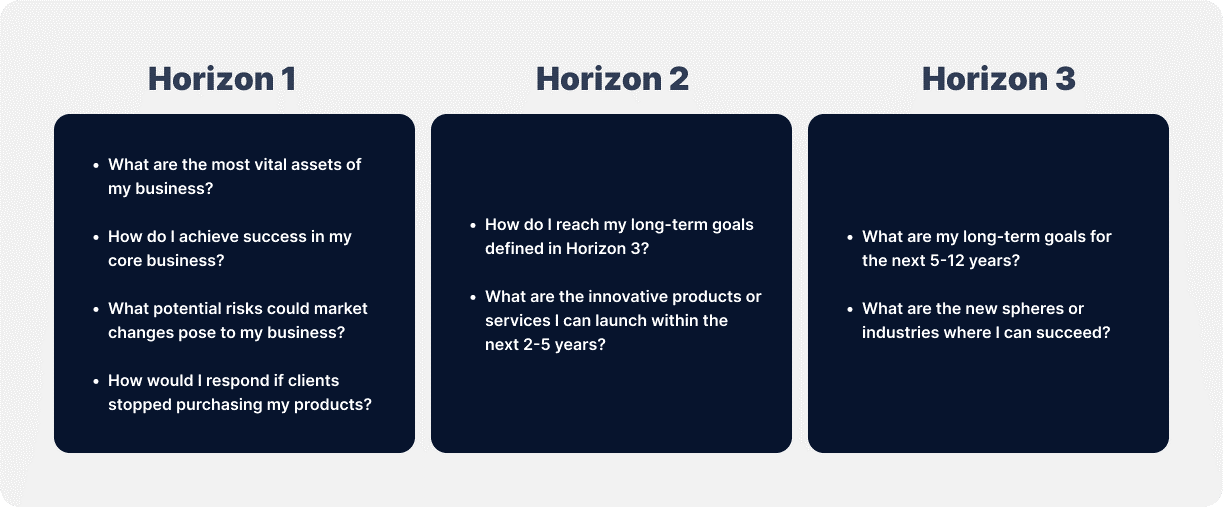McKinsey Growth Pyramid (Three Horizons of Growth)
The McKinsey Three Horizons of Growth framework is a strategic model that guides organizations in managing and sustaining growth over time. By categorizing initiatives into three distinct horizons—Horizon 1 (core business), Horizon 2 (emerging businesses), and Horizon 3 (future opportunities)—companies can balance immediate performance with long-term innovation. This approach ensures that while current operations are optimized, there is simultaneous investment in future growth areas.

Horizon 1: Core Business (Short-Term Growth)
Horizon 1 focuses on the company's existing core businesses that generate the majority of current revenue and profits. The primary objective here is to defend and extend these core activities to maintain competitiveness and ensure short-term financial stability. This involves continuous improvement, cost optimization, and incremental innovation to enhance existing products or services.
Key Actions in Horizon 1:
- Enhancing Operational Efficiency: Streamlining processes to reduce costs and improve quality.
- Incremental Innovation: Upgrading existing products or services to meet evolving customer needs.
- Market Penetration: Expanding market share through targeted marketing and sales strategies.
Example: A leading consumer electronics company focuses on refining its flagship smartphone line by improving battery life and camera quality, ensuring it remains competitive in the current market.
Horizon 2: Emerging Businesses (Medium-Term Growth)
Horizon 2 encompasses emerging opportunities that have the potential to become significant revenue streams in the medium term. These initiatives often arise from existing capabilities but target new markets or customer segments. Investing in Horizon 2 involves allocating resources to scale these opportunities, bridging the gap between the core business and future ventures.
Key Actions in Horizon 2:
- Market Development: Introducing existing products to new geographical areas or demographics.
- Product Diversification: Developing new products or services related to the current portfolio.
- Strategic Partnerships: Collaborating with other companies to leverage complementary strengths.
Example: An established automotive manufacturer invests in developing electric vehicles, aiming to capture the growing market demand for sustainable transportation solutions.
Horizon 3: Future Opportunities (Long-Term Growth)
Horizon 3 is dedicated to exploring and nurturing ideas that could lead to entirely new businesses or industries in the long term. These opportunities are often experimental and may not generate revenue immediately but are crucial for the company's future growth and adaptability. Embracing Horizon 3 requires a culture of innovation and a willingness to invest in uncertain but potentially transformative projects.
Key Actions in Horizon 3:
- Research and Development: Investing in cutting-edge technologies and exploring their applications.
- Incubation of New Ideas: Creating internal startups or innovation labs to experiment with novel concepts.
- Venture Investments: Funding external startups or acquiring companies with promising technologies or business models.
Example: A global technology firm explores quantum computing, investing in research that could revolutionize data processing and open new business avenues in the future.
Integrating the Three Horizons
For the Three Horizons framework to be effective, organizations must manage all three horizons concurrently. This integrated approach ensures that while the core business thrives, emerging and future opportunities are cultivated to sustain long-term growth.

Strategies for Integration:
- Resource Allocation: Balancing investment across all horizons to avoid neglecting future growth for short-term gains.
- Leadership Commitment: Ensuring top management supports and actively engages in initiatives across all horizons.
- Cultural Adaptability: Fostering an organizational culture that encourages innovation and accepts the risks associated with exploring new opportunities.
Example: A multinational conglomerate allocates a portion of its annual budget to Horizon 3 projects, establishing a dedicated team to explore disruptive technologies while its main divisions focus on optimizing current operations and scaling emerging businesses.
Challenges and Considerations
While the Three Horizons framework offers a structured approach to growth, companies may face challenges in its implementation:
- Short-Term Focus: Pressure for immediate results can lead to under investment in Horizons 2 and 3.
- Risk Aversion: Uncertainty associated with long-term projects may deter investment in Horizon 3 initiatives.
- Resource Constraints: Allocating sufficient resources across all horizons requires careful planning and prioritization.
Mitigation Strategies:
- Establish Clear Metrics: Developing specific performance indicators for each horizon to track progress and justify investments.
- Encourage a Balanced Portfolio: Diversifying initiatives to include a mix of low-risk and high-reward projects across the horizons.
- Promote a Learning Culture: Encouraging experimentation and viewing failures as learning opportunities to foster innovation.
Final Thoughts
The McKinsey Three Horizons of Growth framework provides a comprehensive road-map for organizations aiming to achieve sustainable growth. By simultaneously managing and investing in core businesses, scaling emerging opportunities, and exploring future possibilities, companies can navigate the complexities of the modern business landscape.
This balanced approach not only secures short-term performance but also builds a robust foundation for long-term success.
Featured Blogs

BCG Digital Acceleration Index

Bain’s Elements of Value Framework

McKinsey Growth Pyramid

McKinsey Digital Flywheel

McKinsey 9-Box Talent Matrix

McKinsey 7S Framework

The Psychology of Persuasion in Marketing

The Influence of Colors on Branding and Marketing Psychology







